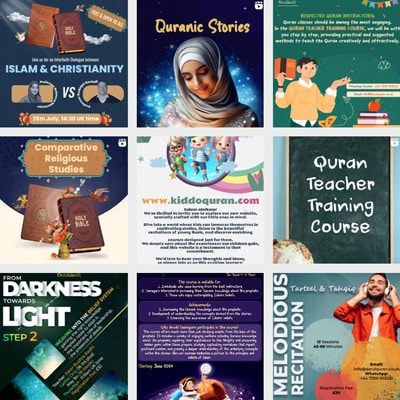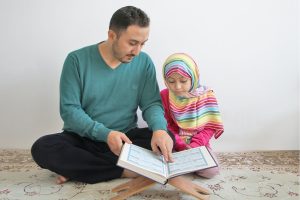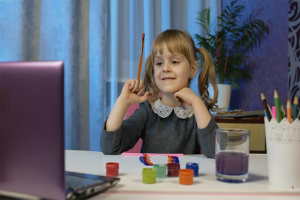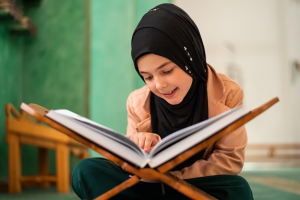Even if we do not have hope of Paradise, fear of Fire, and waiting for reward or punishment, it is proper to follow the moral characters, for these are of things that show the way of success.
Ali ibn Abi Talib (as)
This paper examines how music affects the development of children’s brains emphasizing cognitive enhancement, emotional regulation, socialization abilities and language development among other areas.
Structured musical activities such as melodious recitation lessons organized by institutions like DarulQuran Academy will also be looked into in order to create a conducive atmosphere for integral growth among children.
- The Science of Music and Brain Development
1.1. The Developing Brain
During the early stages of life, your brain goes through a lot of changes that are very interesting. This happens from when you are born up to when you reach teenagerhood where it is undergoing rapid development and growth. All these changes have an impact on mental capabilities, emotional control, and social behavior. Neurodevelopment occurs under genetic and environmental stimuli showing the significance of caregiving experiences in crucial stages of early growth.
During the first few years of life, the human brain forms an astonishing number of neural connections—approximately one million synapses per second. This period is characterized by heightened plasticity, allowing for adaptability in response to experiences. For instance, exposure to language in early childhood plays a crucial role in linguistic development; children who engage with rich linguistic environments tend to develop stronger language skills compared to those who do not. Furthermore, research indicates that adverse experiences such as trauma or neglect can disrupt normal brain development, potentially leading to long-term cognitive and emotional challenges.
As children transition into adolescence, significant structural and functional changes occur within the brain. The prefrontal cortex, responsible for executive functions such as decision-making and impulse control, undergoes prolonged maturation. Concurrently, limbic structures associated with emotion become more active during this period. This developmental trajectory explains many behavioral phenomena observed in adolescents—including heightened risk-taking behaviors—while also underscoring the necessity for supportive environments that promote healthy brain development throughout these formative years.
1.2. Neural Pathways and Music
Several regions of the brain, like memory, emotion and motor skills are engaged in music. The listening or playing of music by children stimulates their brains in such a way that it promotes the growth of fresh neural pathways. Such pathways make communication lines between left and right hemispheres clearer; this results in better coordination, spatial reasoning as well as improved auditory processing.
1.3. Neurochemical Effects of Music
Neurotransmitters such as dopamine, oxytocin and endorphins associated with sexual pleasure, social bonding and stress relief are formulated when music is played. The pleasurable effects of these neurochemical compounds may induce a kind of cycle that encourages more engagement with music hence enhancing brain growth. - Cognitive Benefits of Music
2.1. Enhanced Memory and Attention
Studies have shown that music can improve cognitive tasks for children such as listening and remembering thing better than they were doing before. For example, studies show that children who participate regularly in lessons involving musical instruments have improved recall capacity particularly in regards to spoken information compared with their peers who lack this experience. This happens because learning any instrument often requires memorizing different notes and recalling them later which strengthens areas responsible for storing memories in the brain.
This music-memory relationship can be explained by complex neural paths activated during musical engagement. For example, an area of the brain known to be essential for new memory formation called the hippocampus is more active when people hear or play music. Furthermore, the rhythmic and melodic structures inherent in music facilitate mnemonic devices that aid in information encoding. Research suggests that students exposed to background music while studying demonstrate enhanced recall abilities compared to those who study in silence. This phenomenon underscores the potential of music as a pedagogical tool that can optimize learning environments.
In addition to memory enhancement, music plays a pivotal role in improving attention span. Engaging with complex musical compositions requires focused listening skills and sustained concentration—a practice that translates into improved attentional control in other areas of life. Studies have shown that individuals with regular exposure to music exhibit superior performance on tasks requiring selective attention and cognitive flexibility. Therefore, integrating music into daily routines not only enriches personal experiences but also cultivates essential cognitive skills that are beneficial across diverse contexts.
2.2. Improved Executive Function
Cognitive processes that are part of executive function include working memory, flexible thinking and self-control. Research has shown that children who participate in musical activities improve their executive functions which can lead to better problem-solving skills, enhanced focus as well as increased multitask performance.
Additionally, inherent structure and rhythm of music may help improve organization and planning abilities. For instance, when one learns how to read sheet music or compose original pieces; they have to be able to predict what will happen next based on the input they have at that moment. This aspect of musical engagement translates into improved organizational strategies in other domains such as academics and daily life management. Additionally, collaborative musical activities promote social cognition by requiring participants to communicate effectively and adaptively respond to one another’s cues. Thus, the intersection between music and cognitive development underscores the multifaceted nature of learning processes that extend beyond traditional educational paradigms.
2.3. Language and Literacy Skills
The most important parts of a person’s mental growth are the ability to read and write as well as the ability to speak and use language, which recent studies have shown can be greatly influenced by the involvement in music. Because of its complicated structures and a multifarious of auditory contents, music stimulates a variety of thinking methods that coincide much with the process of learning languages. Research indicates that those kids who are exposed to music during their early years show an increased performance on phoneme awareness tests, a prerequisite for improved reading skills. Additionally, the rhythmic and melodic patterns inherent in music allow us to easily identify sounds and syllables thereby boosting children’s ability to understand what is on paper.
Moreover, the interplay between music and language extends beyond mere phonetic similarities; it also encompasses broader linguistic skills such as vocabulary development and comprehension. Engaging with music often involves lyrics that introduce new words and concepts within a contextual framework, fostering an enriching environment for vocabulary expansion. Furthermore, singing or performing songs requires active listening and memory recall—skills that are directly transferable to reading comprehension tasks. As learners navigate through musical narratives, they practice inferencing and predicting outcomes, which are essential strategies in understanding textual materials.

- Emotional and Social Benefits of Music
3.1. Emotional Regulation
For centuries, the ability of music to affect people’s feelings and interactions with each other has been lauded. In particular, music’s role in emotion regulation is an important area for people who use it to control their state of mind as they want. You could feel happy or sad depending on what kind of song you listen to. It can pour out nostalgic memories back into your memory or provoke anger too, thereby causing what people call complex emotions like nostalgia and anger together at once. Thus, in this way emotional contact becomes a method for one to understand his/her emotions including mourning tracks that are so nice and calming while you are expressing amorous feelings? Therefore, music helps individuals improve their moods or remove negative thoughts so they will be psychologically healthy at all times.
Moreover, the social benefits of music are equally noteworthy. Music acts as a conduit for social connection and bonding among individuals. Participating in musical activities—such as group singing or attending concerts—fosters a sense of community and shared experience. These communal activities not only enhance individual emotional regulation but also contribute to collective well-being by strengthening interpersonal relationships. The act of sharing musical experiences can lead to increased empathy and understanding among participants, facilitating deeper connections that transcend verbal communication.
3.2. Social Skills and Cooperation
Socialization and cooperation become some of the important things when it comes to music. Emotional and social gains accrue from being involved in music in any way, including group performance or writing songs together. Taking part in musical shows or cooperative composing requires that you interact with other people and work as a team. All these interactions promote several vital social skills like empathy, active listening, negotiation skills, etc. Through this process of finding a common ground in harmonizing their work, they learn how to deal with different issues so that they can appreciate each other’s position better and develop lasting connections.
Moreover, music inherently encourages cooperation through its reliance on collective engagement. Group-based musical experiences—such as choir singing or ensemble playing—require individuals to synchronize their efforts towards a common goal. This shared endeavor not only strengthens interpersonal bonds but also fosters a sense of belonging among participants. The resulting community spirit can alleviate feelings of isolation and enhance emotional well-being, particularly in educational settings where collaboration is vital for personal development.
The emotional benefits derived from engaging with music extend beyond mere enjoyment; they encompass profound psychological effects that promote resilience and self-regulation. Participation in musical groups often leads to increased self-esteem as individuals receive validation from peers during collaborative efforts. This boost in confidence can enhance one’s ability to navigate social situations more effectively, further reinforcing the cycle of improved social skills and cooperative behavior.
3.3. Cultural Awareness and Identity
A pivotal role in constituting cultural awareness and identity positioning music like universal language. People can, therefore, explore their heritage while relating meaningfully with diverse cultural aspects through music-culture relationship. As they interact dynamically with it, people will be able to delve deeper into their own cultural roots which help them affirm their identities. This enables people to appreciate different styles of music and traditions making them realize how rich other cultures are hence enhancing emotional intelligence and social connectivity (Thing 2).
Moreover, music serves as a powerful medium for expressing emotions that may be difficult to articulate through conventional means. By engaging with music from various cultures, individuals can resonate with experiences that reflect both personal and collective narratives. This emotional engagement not only facilitates self-discovery but also promotes empathy towards others’ experiences. As people listen to songs that convey themes of struggle, joy, or resilience from different cultural backgrounds, they become more attuned to the complexities of human emotions across societies.
In addition to fostering emotional benefits, music also encourages social cohesion by bringing people together in shared experiences. Whether through communal performances or participatory practices like singing and dancing, music creates spaces for interaction that transcend linguistic barriers and cultural divides. These shared musical experiences enhance social bonds among community members while promoting inclusivity and mutual respect for diversity. Ultimately, the interplay between cultural awareness and identity through music not only enriches individual lives but also strengthens societal ties in an increasingly interconnected world. - The Role of Music in Special Education
4.1. Music Therapy for Developmental Disorders
There are many children who have autistic spectrum disorder (ASD) or attention deficit hyperactivity disorder (ADHD) that can benefit from music therapy. Autism is a severe mental disorder that is characterized by lack of ability to understand and use verbal and non-verbal communication, social skills deficits, and aberrant behavior patterns. It occurs in every culture and background, affecting both genders equally. Therapeutic intervention helps to build more connections among these components leading to better regulation of emotions, improved communication ability, and increased social competence. Music therapy provides these children with an opportunity for non-verbal expression as well as interaction.
4.2. Enhancing Learning in Children with Dyslexia
Kids who have dyslexia usually experience difficulties in phonological processing and auditory discrimination. By enhancing sound and rhythm processing in the brain, music instruction can boost these abilities and thus lead to better reading and language results.
4.3. Motor Skill Development in Children with Physical Disabilities
Using music as a motivational medium for engagement in physical activity is an important consideration for children with disabilities. Playing instruments as well as participating in dance and movement have also shown to enhance things like coordination, balance, and fine motor abilities hence contributing to their general body development.

- Music in Early Childhood Education
5.1. Incorporating Music into the Curriculum
It is a fundamental basis in early childhood education on which all round development of young learners thrives with incorporation of music into the curriculum. Music is not just an art but it acts as a strong teaching tool that boosts brain development, socialization and emotional growth. Regular studies have proved that memory retention and language acquisition can be enhanced by listening to or playing music, thus making it vital instrument for early learning institutions. When kids participate in musical activities including singing, dancing and instrument playing they are able to acquire important skills such as critical listening and phoneme awareness which play significant roles in acquiring literacy.
Moreover, music fosters social interaction among peers. Group activities centered around music encourage collaboration and communication skills as children learn to work together in harmony. These interactions help cultivate a sense of community within the classroom setting, promoting inclusivity and teamwork. For instance, participating in rhythm-based games or ensemble performances allows children to experience shared goals and collective achievements while also appreciating diverse musical traditions from various cultures.
Additionally, incorporating music into early childhood education supports emotional regulation and self-expression. Music provides a safe outlet for children to explore their feelings and experiences creatively. Through songwriting or improvisation activities, they can articulate emotions that may otherwise be difficult to express verbally. This not only aids in emotional intelligence but also builds resilience as children learn to navigate their feelings through artistic means.
5.2. Play-Based Learning and Music
Musical activities easily suit play-based learning, which emphasizes on exploration as well as discovery. Through singing, dancing and playing musical instruments children create an opportunity to learn about sound, patterns and rhythms thereby promoting creative thinking as well as imaginative part of them.
5.3. Parent and Teacher Involvement
To augment a child’s musical growth parents as well as teachers are very important. For instance, at home and in school encouraging musical activities can lead to a rich supportive environment where children can explore their musical interests and talents. - The Benefits of Melodious Recitation for Children
6.1. Cognitive and Linguistic Advantages
Melodious recitation, such as the rhythmic and melodic recitation of religious texts, can provide significant cognitive and linguistic benefits for children. This form of recitation enhances memory, attention, and language skills by engaging auditory and verbal processing centers in the brain.
6.2. Emotional and Spiritual Development
Melodious recitation can also promote emotional and spiritual development in children. The soothing and rhythmic nature of recitation can have a calming effect, helping children manage stress and anxiety. Additionally, the spiritual content of these recitations can provide a sense of purpose and belonging, fostering moral and ethical development.
6.3. Social and Cultural Enrichment
Participating in melodious recitation activities can enhance children’s social and cultural understanding. These activities often involve group participation, promoting teamwork, cooperation, and a sense of community. Moreover, they expose children to cultural traditions and values, enriching their understanding of their heritage and fostering a sense of identity. - Melodious Recitation Online Courses for Kids at DarulQuran Academy
7.1. Overview of DarulQuran Academy
DarulQuran Academy is a leading institution that offers a range of online courses designed to foster the spiritual, cognitive, and emotional development of children. The academy emphasizes the importance of holistic education, integrating traditional learning with modern teaching methods.
7.2. The Melodious Recitation Online Courses
The Melodious Recitation Online Courses for Kids at DarulQuran Academy provide an excellent opportunity for children to engage in melodious recitation in a structured and supportive environment. These courses are designed to enhance children’s cognitive abilities, language skills, and emotional well-being through the art of melodious recitation.
7.3. Benefits of Enrolling in the Course
Enrolling in the Melodious Recitation Online Courses at DarulQuran Academy offers several benefits for children:
• Cognitive Development: The courses help improve memory, attention, and linguistic skills by engaging children in structured recitation activities.
• Emotional Well-being: The calming effects of melodious recitation can help children manage stress and develop emotional resilience.
• Cultural and Spiritual Growth: The courses provide children with a deeper understanding of their cultural and spiritual heritage, fostering a sense of identity and belonging.
7.4. Course Structure and Features
The courses are designed to be flexible and accessible, accommodating different learning styles and schedules. Key features include:
• Interactive Lessons: Engaging and interactive lessons that make learning enjoyable and effective.
• Qualified Instructors: Experienced instructors who are skilled in teaching melodious recitation to children.
• Community Engagement: Opportunities for children to connect with peers and participate in group recitations, fostering a sense of community.
In Conclusion Music and melodious recitation have a profound impact on children’s brain development, influencing cognitive, emotional, and social skills. By integrating these activities into early education and daily life, we can enhance children’s overall development and well-being. Programs like the Melodious Recitation Online Courses for Kids at DarulQuran Academy provide a valuable platform for children to explore the benefits of melodious recitation in a supportive and nurturing environment, contributing to their holistic growth and development.


















